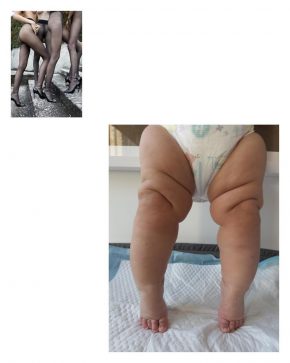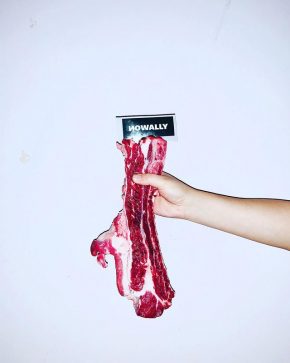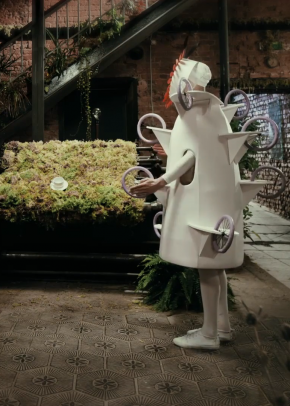
Traditional Japanese fisherman’s flags that celebrate a large catch of fish and have helped illuminate Japanese ports.
If you’ve ever been inside a Japanese-style restaurant specializing in fish-based dishes, chances are you’ve seen a “Tairyo-bata.” The flags, which depict dyed patterns of waves, ships, fish, names of ships and sometimes good luck charms such as the rising sun, crane and tortoise motifs and Mt. Fuji on large fabrics that sometimes exceed a width of one meter, signify a “big catch of fish.” Like many other traditional flags, the Tairyo-bata was an important tool used to convey a message to distant locations during a time when such things as wireless communication was not available.
Whenever a fishing boat returns to port and this flag is raised off the coast, the people waiting at the port understood in advance that there was a lot of work to be done to unload the big catch of fish and could prepare accordingly. When little or no fish were caught, the flag was not raised, or in some regions, a white flag was raised instead. The Tairyo-bata were also used as a signal to request the transfer of fish from one boat to another on days when the hauls were too big to fit onto a single boat. Typically, the flags were presented to owners of newly built fishing boats, as a gift from their fishing partners or relatives, and it was customary practice to present them during launching ceremonies.


The origin of the Tairyo-bata remains unclear, and while some people say that similar versions of them were used during the middle of the Edo period, the flags at the time did not feature any pattern designs, and instead were made with hemp fabrics and featured simple red or white designs that were easy to identify out on the sea.
The colorful style of flags that you see today first appeared after World War II, and the roots of the flashy designs were said to have come from “Maiwai,” a type of formal attire that was typically given to seamen by the ships owner to commemorate a big catch, and also from livery coats called “Tairyo kanban.” It is said that high-spirited fishermen favor the dynamic and majestic patterns as well as arrangements.

With the evolution of communication methods, the Tairyo-bata has lost its original function as a tool, where today they are typically used decoratively in festive occasions such as the launching of newly built ships, in observance of the New Year, and in restaurants.
“Takahashi Somemonoten,” which has been around for over 120 years in Yaizu, Shizuoka Prefecture, a fishing port that boasts Japan’s biggest hauls of fish, is one of the two remaining dyers in the prefecture that manufactures Tairyo-batas. Hiroyuki Takahashi, the store’s third-generation owner, remembers his father, the previous owner, hard at work manufacturing Tairyo-batas every night during the 1960s, when the ports in Yaizu were bustling with countless bonito and tuna fishing boats.



Today, the Tairyo-batas are still dyed using the same traditional techniques as in the past. The white canvases are spread out horizontally and after applying a layer of dye-resistant paste made from a combination of glutinous rice and rice bran to the outline of the pattern, the different colored dyes are applied with a brush. The process of evenly rubbing various colored dyes, typically ranging from red, green, blue and black onto each section of the large flag is more elaborate than you might imagine and takes a long time to complete.
After dyeing the flags, they are dried under natural sunlight and then washed with water to remove the paste. After drying them under the sun a second time, the beautiful Tairyo-batas are completed.


Today they manufacture flags not only for fishing boats but also quite frequently for a variety of corporations and sports teams. In their studio, they also hold workshops that are open to the general public where people can experience dyeing Tairyo-batas (Note: Workshops are currently suspended due to the passing of Mr. Takahashi).
Tairyo-bata have illuminated these ports for years and spurred by the sight of the stunning seas of Yaizu, craftsmen continue to pass down this cultural relic to coming generations.
*In June 2016, Takahashi Somemonoten owner Hiroyuki Takahashi passed away. We offer our deepest condolences to the Takahashi family. This article was originally written in September 2015.

TAKAHASHI SOMEMONO STORE
1-12-10 OGAWA SHINMACHI, YAIZU CITY, SHIZUOKA 425-0031
054-628-2554
Business Hours : 9:00 – 19:00
Closed : No scheduled
Survey, defined as: to examine or inspect. In these features, we will be reporting on things, people, places, or cultures that inspire us in our daily work of making products.
edit & text: Kosuke Ide
photo: Keisuke Fukamizu


























Comments